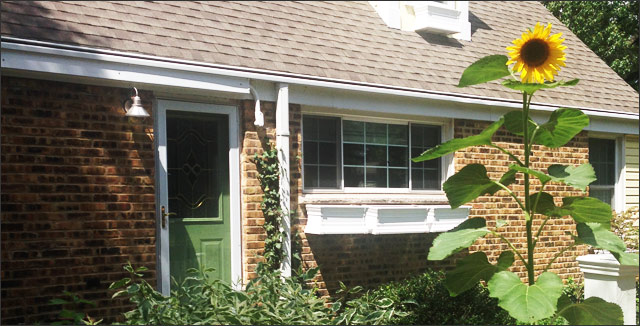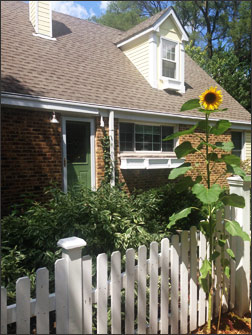
Growing Sunflowers – Everything You Need to Know

What speaks summer more like the beautiful bright yellow colors of a soaring sunflower? With their sun-like appearance and towering height, they demand attention and appreciation. Their ability to grow in just about any soil makes them an easy, yet stunning addition to any home or business landscape.
Sunflowers are unique in that at first glance it looks like just one flower with the yellow petals circling around the inside. However, when you take a closer look, you will see that the inside of every sunflower is actually made up hundreds of tiny little flowers. These incredible flowers are dramatic and demand attention for all those who pass by.
In addition, sunflowers are an amazing flower choice to grow with children too as they can grow to huge heights and they grow fast. There are a number of different varieties of sunflowers that you can choose from. Having your child help you choose which variety will be an engaging and fun activity. You can grow a number of varieties and then use tape measure to see how tall they grow.
Choosing Your Sunflowers
Here are three types of sunflowers that you might like to try growing.
- Teddy Bear Sunflowers
If you are looking for a shorter sunflower, you might want to choose the teddy bear variety as they mature at about three feet tall. - Sunbeam Sunflowers
If you are looking for a medium size flower the sunbeam varieties would be a great choice. These flowers will get to a height of about five feet tall and will grow a flower to about five inches. These flowers have a dramatic yellow middle and make for great centerpieces. - Autumn Beauty Sunflowers
However, if you are looking for those towering sunflowers, the autumn-beauty can grow up to six or seven feet in height and have a flower about six inches in size.
5 Must Have Tips for Growing Sunflowers

- Sunflowers Need Full Sun
Summers with long, hot days are the perfect place for growing sunflowers. As their name says it all, these flowers need lots of sun. When you grow these flowers, watch as the direction of the flower head will move from east to west as if they are literally reaching for every inch of sun they can get.Not giving these flowers enough sun was one of the first mistakes that I made when growing sunflowers. The first time I ever grew sunflowers, I placed them in a line along my fence. I had three at one entrance to our yard and three on the other. I had high hopes for beautiful sunflowers towering over all who entered into our yard.
To my disappointment, out of the six sunflowers I planted in that area, only two flowered. One of those two only made it to about three feet.
I noticed that the flowers that did not succeed had been shaded by another tree in our yard. However, the one seedling that had the full sun grew to over seven feet in height and had a flower head of over six inches. When planting sunflowers, they truly do speak their name – they need full sun.
- Use a slow acting fertilizer
The autumn-beauty vigorous flowers can grow up to six feet in just three months. While they do not need too much for growing, it’s a good idea to add a slow releasing fertilizer. If you notice that your sunflowers are not growing very tall or that they actual flower is relatively small, it might be a reflection of poor soil. Use an organic fertilizer that you can mix into the soil before planting. Making sure your sunflowers are fed will help you grow those big, round and full flowers that you have envisioned. - Water
While they can stand some drought, you will find that you will get the best results by giving them a good diet and lots of water. This is a great opportunity to use the Root Stick. This is an aeration tool that you can use in just about any place in your yard. It is easy to install and easy to use. Once placed, these incredible sticks will help you to provide adequate water for your sunflowers to the important root zone. This will help your beautiful plant to grow to those crazy heights.It’s a good idea to water your sunflowers about every other day throughout the summer. You will notice that they will begin to bloom between two to three months after planting.
- Shield From the Wind
When placing your seeds into the ground, it is a great idea to make sure to pick a spot that will be shielded from the wind. A great option would be along a fence or a tree line. If you place your seeds on the north end, you will also help to make sure that when they grow they will not be shading other parts of your garden with their huge stalks. - Well Drained Soil
While sunflowers are resilient plants, it is important to make sure that they are in soil that can drain. These plants can stand almost anything except for flooded soil.
Harvesting Sunflowers

Placing in a Vase
If you do plan to cut your flowers to place into a vase, cut them in the morning and at an angle. Then place them in water. Make sure to change the water out every other day to help your sunflowers stay beautiful and fresh.
Preparing the Sunflower Seeds to be Eaten
You will notice that your flower will be ready to harvest once the head begins to droop and the seeds begin to dry out and turn brown. Take the seeds from the flower and soak in water and salt overnight. Bake the sunflower seeds in the oven at around 200 – 250 degrees Fahrenheit for 30 to 40 minutes or until golden brown.
Take Away
Growing sunflowers will do nothing but bring a smile to your face and brighten your day. Have you ever grown sunflowers? What did you noticed that worked best for them? We would love to hear your thoughts.



